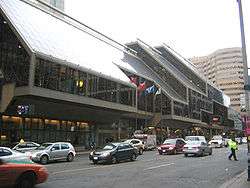Convention (meeting)
A convention, in the sense of a meeting, is a gathering of individuals who meet at an arranged place and time in order to discuss or engage in some common interest. The most common conventions are based upon industry, profession, and fandom. Trade conventions typically focus on a particular industry or industry segment, and feature keynote speakers, vendor displays, and other information and activities of interest to the event organizers and attendees. Professional conventions focus on issues of concern along with advancements related to the profession. Such conventions are generally organized by societies or communities dedicated to promotion of the topic of interest. Fan conventions usually feature displays, shows, and sales based on pop culture and guest celebrities. Science fiction conventions traditionally partake of the nature of both professional conventions and fan conventions, with the balance varying from one to another. Conventions also exist for various hobbies, such as gaming or model railroads.

Conventions are often planned and coordinated, often in exacting detail, by professional meeting and convention planners, either by staff of the convention's hosting company or by outside specialists. Most large cities will have a convention center dedicated to hosting such events. The term MICE—meetings Incentives Conventions and Exhibitions—is widely used in Asia as a description of the industry. The Convention ("C") is one of the most dynamic elements in the M.I.C.E. segment. The industry is generally regulated under the tourism sector.
In the technical sense, a convention is a meeting of delegates or representatives.[1] The 1947 Newfoundland National Convention is a classic example of a state-sponsored political convention. More often, organizations made up of smaller units, chapters, or lodges, such as labor unions, honorary societies, and fraternities and sororities, meet as a whole in convention by sending delegates of the units to deliberate on the organization's common issues.[2] This also applies to a political convention, though in modern times the common issues are limited to selecting a party candidate or party chairman. In this technical sense, a congress, when it consists of representatives, is a convention. The British House of Commons is a convention, as are most other houses of a modern representative legislature. The National Convention or just "Convention" in France comprised the constitutional and legislative assembly which sat from September 20, 1792 to October 26, 1795. The governing bodies of religious groups may also be called conventions, such as the General Convention of the Episcopal Church USA and the Southern Baptist Convention.
Many sovereign states have provisions for conventions besides their permanent legislature. The Constitution of the United States of America has a provision for the calling of a constitutional convention, whereby delegates of the states are summoned to a special meeting to amend or draft the constitution. This process has never occurred, save for the original drafting of the constitution, although it almost happened in several cases. The US Constitution also has provisions for constitutional amendments to be approved by state conventions of the people. This occurred to ratify the original constitution and to adopt the twenty-first amendment, which ended prohibition.
Con is a common abbreviation for convention, and some conventions (such as DEF CON and Gen Con) use it in their names.
Co-located conventions
When two or more conventions are held at the same place and time they are co-located. Co-located conventions are usually in related industries.
See also
- Academic conference
- Annual general meeting
- Business travel
- Caucus
- Convention center
- Delegate
- Event planning
- Forum
- Summit
- Symposium
- Seminar
- Workshop
- Event
- Convention
- Congress
References
| Wikivoyage has a travel guide for Business travel. |
- Robert, Henry M.; et al. (2011). Robert's Rules of Order Newly Revised (11th ed.). Philadelphia, PA: Da Capo Press. p. 7. ISBN 978-0-306-82020-5.
- Robert 2011, pp. 600–601